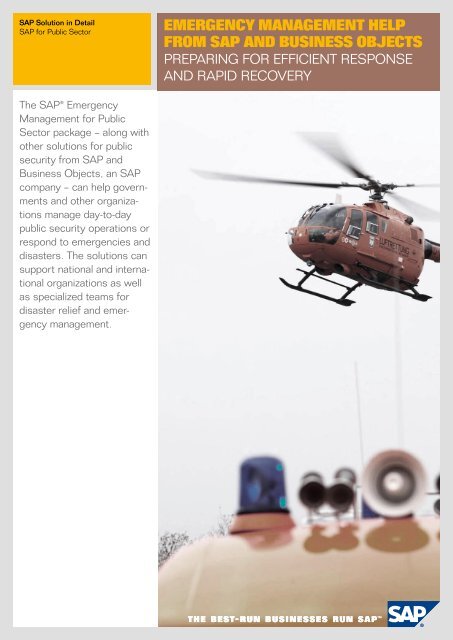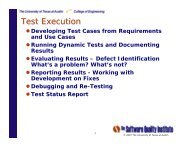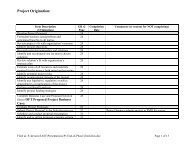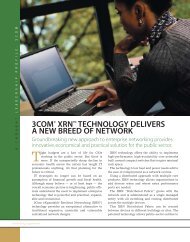Emergency Management HELP from SAP and Business Objects ...
Emergency Management HELP from SAP and Business Objects ...
Emergency Management HELP from SAP and Business Objects ...
You also want an ePaper? Increase the reach of your titles
YUMPU automatically turns print PDFs into web optimized ePapers that Google loves.
<strong>SAP</strong> Solution in Detail<br />
<strong>SAP</strong> for Public Sector<br />
The <strong>SAP</strong>® <strong>Emergency</strong><br />
<strong>Management</strong> for Public<br />
Sector package – along with<br />
other solutions for public<br />
security <strong>from</strong> <strong>SAP</strong> <strong>and</strong><br />
<strong>Business</strong> <strong>Objects</strong>, an <strong>SAP</strong><br />
company – can help governments<br />
<strong>and</strong> other organizations<br />
manage day-to-day<br />
public security operations or<br />
respond to emergencies <strong>and</strong><br />
disasters. The solutions can<br />
support national <strong>and</strong> international<br />
organizations as well<br />
as specialized teams for<br />
disaster relief <strong>and</strong> emergency<br />
management.<br />
EmErgEncy managEmEnt <strong>HELP</strong><br />
<strong>from</strong> SaP <strong>and</strong> BuSinESS oBjEctS<br />
PREPARING FOR EFFICIENT RESPONSE<br />
AND RAPID RECOVERY
contEnt<br />
4 Timely Information for All<br />
Stakeholders<br />
6 A Comprehensive <strong>Emergency</strong><br />
<strong>Management</strong><br />
Framework<br />
7 Assessment<br />
8 Prevention <strong>and</strong> Preparation<br />
9 Response <strong>and</strong> Resolution<br />
10 Rebuilding<br />
11 A Wide Range of Organizational<br />
Benefits
timELy information for<br />
aLL StakEHoLdErS<br />
FOR FullY INTEGRATED, END-TO-END<br />
SuPPORT<br />
It seems that not a day<br />
goes by without a major<br />
emergency or disaster in<br />
the headlines. Whether an<br />
incident is related to the<br />
weather, technological failure,<br />
human error, a biological<br />
accident, or an act of<br />
terrorism, public sector<br />
organizations must effectively<br />
manage the entire<br />
spectrum of related risks<br />
<strong>and</strong> consequences.<br />
One of the biggest challenges for these<br />
organizations is helping a broad range<br />
of public security stakeholders work<br />
together effectively <strong>and</strong> providing the<br />
specific information each stakeholder<br />
requires – as soon as possible. In<br />
medical emergencies, for example, the<br />
“golden-hour rule” holds that the chances<br />
of survival are greatest if a victim<br />
receives proper care within 60 minutes<br />
of a serious injury.<br />
Timely access to information must be<br />
available to all stakeholders in response<br />
to inbound requests for resources,<br />
emerging events at the incident site,<br />
the needs of personnel h<strong>and</strong>ling the<br />
incident, <strong>and</strong> actions that have been<br />
taken to manage the incident. To maintain<br />
appropriate comm<strong>and</strong> <strong>and</strong> control<br />
of an emergency situation, stakeholders<br />
must fully underst<strong>and</strong> the nature of<br />
the situation, the risks involved, <strong>and</strong><br />
possible response strategies – seg-<br />
mented by incident, comm<strong>and</strong> level,<br />
<strong>and</strong> organization. Stakeholders also<br />
need accurate <strong>and</strong> complete contact<br />
information about each other.<br />
In addition, stakeholders must be able<br />
to activate preplanned responses that<br />
involve multiple organizations both rapidly<br />
<strong>and</strong> effectively. Helping each organization<br />
underst<strong>and</strong> its particular<br />
responsibilities can minimize the chaos<br />
period of an emergency or disaster <strong>and</strong><br />
facilitate rapid movement to a more<br />
effectively coordinated controlled period,<br />
as shown in Figure 1.<br />
To be effective, public security organizations<br />
need IT solutions for emergency<br />
management that are fully integrated<br />
<strong>and</strong> provide end-to-end support. This<br />
includes support for call h<strong>and</strong>ling <strong>and</strong><br />
resolution, rostering, <strong>and</strong> resource<br />
management – as well as for geographic<br />
information systems (GIS), mobile<br />
systems, knowledge management, <strong>and</strong><br />
analytics. The solutions should provide<br />
a centralized view of all resources <strong>and</strong><br />
their readiness status <strong>and</strong> support a<br />
highly flexible, fully integrated framework<br />
for organizational management.<br />
Chaos period<br />
Orientation<br />
• Unsecured <strong>and</strong><br />
incon sistent<br />
data<br />
• Small number<br />
of action forces<br />
• Unclear<br />
management<br />
structures<br />
• Incomplete<br />
situation report<br />
• Extreme time<br />
pressure<br />
• Inflexible<br />
structures<br />
Figure 1: Key Characteristics of an <strong>Emergency</strong><br />
4 <strong>SAP</strong> Solution in Detail – <strong>Emergency</strong> <strong>Management</strong> Help <strong>from</strong> <strong>SAP</strong> <strong>and</strong> <strong>Business</strong> <strong>Objects</strong><br />
Controlled period<br />
• Variance<br />
among<br />
priorities for<br />
participating<br />
organizations<br />
<strong>and</strong> personnel<br />
• Information<br />
overflow<br />
In addition to aligning an organization’s<br />
processes for incident <strong>and</strong> resource<br />
management, such an integrated framework<br />
makes it easy to coordinate emergency<br />
resources <strong>and</strong> programs for a<br />
diverse range of organizations <strong>and</strong><br />
geographies. This framework must<br />
assure that all processes can operate<br />
in a decentralized manner when necessary.<br />
Even if your primary sources for<br />
data include multiple systems, databases,<br />
applications, <strong>and</strong> safety sensors, a<br />
well-integrated solution framework can<br />
serve as the operation hub that helps<br />
you effectively prepare for <strong>and</strong> respond<br />
to any emergency or disaster that<br />
might occur.<br />
The <strong>SAP</strong>® <strong>Emergency</strong> <strong>Management</strong><br />
for Public Sector package – along with<br />
other solutions <strong>from</strong> <strong>SAP</strong> <strong>and</strong> <strong>Business</strong><br />
<strong>Objects</strong>, an <strong>SAP</strong> company – offer comprehensive,<br />
fully integrated support for<br />
emergency management that includes:<br />
• A preparedness framework for all<br />
aspects of incident h<strong>and</strong>ling – <strong>from</strong><br />
developing actionable intelligence to<br />
creating <strong>and</strong> managing emergency<br />
task forces<br />
Decision Prevention Clearance<br />
• Cause analysis<br />
• Reduction<br />
in action<br />
forces <strong>and</strong><br />
substructures<br />
Back to<br />
normal<br />
• Reconstitution<br />
of operational<br />
readiness<br />
• Reconstruction<br />
of structures
One of the biggest<br />
challenges public<br />
security organizations<br />
face is helping a broad<br />
range of public security<br />
stakeholders work<br />
together effectively<br />
<strong>and</strong> providing the specific<br />
information each<br />
stakeholder requires –<br />
as soon as possible.<br />
• An integrated response hub for various<br />
aspects of comm<strong>and</strong> <strong>and</strong> control<br />
– <strong>from</strong> contingency planning, information<br />
management, resource management,<br />
personnel assignment, <strong>and</strong><br />
task force deployment to the management<br />
of first responders <strong>and</strong> their<br />
missions<br />
• A modular application framework for<br />
all aspects of postdisaster management<br />
– <strong>from</strong> integrated case management<br />
<strong>and</strong> volunteer management to<br />
reconstruction planning <strong>and</strong> casualty<br />
follow-ups<br />
• Operations <strong>and</strong> resource management<br />
tools for a comprehensive view<br />
of public security resources <strong>and</strong> the<br />
integrated management of those<br />
resources with finance, logistics,<br />
procurement, <strong>and</strong> tasking functions<br />
The solutions are based on the serviceoriented<br />
architecture of the <strong>SAP</strong><br />
NetWeaver® technology platform. This<br />
architecture lets you take advantage<br />
of the flexibility, efficiency, <strong>and</strong> reusability<br />
of Web-based services across your<br />
IT l<strong>and</strong>scape – without increasing overall<br />
costs. It also offers a blueprint for<br />
composing <strong>and</strong> evolving innovative<br />
applications for integrated emergency<br />
management, while providing the flexibility<br />
to make cost-effective process<br />
changes. The result is a robust,<br />
scalable, <strong>and</strong> modular answer for managing<br />
key aspects of emergency management<br />
across your organization <strong>and</strong><br />
the organizations with which you<br />
interact.<br />
Solutions in Action:<br />
<strong>SAP</strong> NetWeaver®<br />
Since 2005, Switzerl<strong>and</strong>’s Koordinierter<br />
Sanitätsdienst (Coordinated<br />
Medical Service) has used a Webbased<br />
emergency management<br />
system built on the <strong>SAP</strong> NetWeaver®<br />
technology platform to deliver<br />
rapid medical assistance to disaster<br />
victims. The system helps emergency<br />
staff match individual victims<br />
to the most appropriate hospital<br />
within seconds – while providing a<br />
comprehensive overview of available<br />
medical resources, st<strong>and</strong>ard<br />
disaster best practices, <strong>and</strong> a<br />
robust model for coordinating<br />
disaster management.<br />
<strong>SAP</strong> Solution in Detail – <strong>Emergency</strong> <strong>Management</strong> Help <strong>from</strong> <strong>SAP</strong> <strong>and</strong> <strong>Business</strong> <strong>Objects</strong><br />
5
a comPrEHEnSivE EmErgEncy<br />
managEmEnt framEwork<br />
SuPPORT ACROSS THE EMERGENCY<br />
MANAGEMENT VAluE CHAIN<br />
Solutions for public security <strong>from</strong> <strong>SAP</strong><br />
<strong>and</strong> <strong>Business</strong> <strong>Objects</strong> provide a single,<br />
fully integrated platform for emergency<br />
management that is built on open st<strong>and</strong>ards.<br />
As a result, the software works<br />
with a diverse range of data sources,<br />
applications, safety sensors, <strong>and</strong> technologies.<br />
This means, for example, that<br />
software for comm<strong>and</strong> <strong>and</strong> control<br />
used by one organization can collect<br />
sensor information <strong>from</strong> a second organization<br />
as well as resource management<br />
data <strong>from</strong> a third organization to<br />
h<strong>and</strong>le a particular incident.<br />
The solutions are proven, robust,<br />
scalable, secure, <strong>and</strong> flexible enough to<br />
serve the long-term requirements of<br />
your organization. They provide realtime,<br />
consolidated information that can<br />
facilitate faster <strong>and</strong> more reliable decision<br />
making. The fully integrated platform<br />
can support defense, government,<br />
<strong>and</strong> security <strong>and</strong> safety activities<br />
across many locations <strong>and</strong> user communities.<br />
It provides a common architecture<br />
through which you can securely<br />
capture, classify, store, analyze, <strong>and</strong><br />
access the st<strong>and</strong>ardized templates,<br />
forms, reports, alerts, workflows, <strong>and</strong><br />
information you need for effective<br />
emergency management.<br />
Such support can improve communications<br />
<strong>and</strong> decision making by providing<br />
an emergency management infrastructure<br />
that spans national, regional, <strong>and</strong><br />
local resources. A modular, incremental<br />
implementation approach enables<br />
deployment in a variety of geographic<br />
<strong>and</strong> emergency management situations<br />
– <strong>from</strong> minor incidents to major<br />
disasters.<br />
The solutions provide strong operational<br />
support across the complete emergency<br />
management value chain with<br />
robust functionality for:<br />
Risk management. The solutions can<br />
help you proactively identify, analyze,<br />
respond to, <strong>and</strong> monitor risk across<br />
your particular areas of responsibility.<br />
Organizational management. You can<br />
use the software to control your personnel<br />
<strong>and</strong> material resources more<br />
effectively, establish a flexible organizational<br />
structure, automate your transport<br />
processes, create a qualificationbased<br />
staffing process, <strong>and</strong> prepare<br />
capability-based teams of emergencyreadiness<br />
personnel.<br />
Operations <strong>and</strong> resource management.<br />
The solutions can help you plan<br />
<strong>and</strong> schedule personnel <strong>and</strong> material<br />
resources – either ad hoc or using a<br />
predefined operations template for<br />
emergency events.<br />
GIS enablement. You can deploy GIS<br />
functionality wherever it is needed<br />
through integration with a GIS solution<br />
such as the one offered by ESRI, an<br />
<strong>SAP</strong> software partner. The software<br />
Public<br />
security<br />
stakeholders,<br />
first<br />
responders,<br />
<strong>and</strong> so on<br />
Timely access to information<br />
must be available<br />
to all stakeholders<br />
in response to<br />
inbound requests for<br />
resources, emerging<br />
events at the incident<br />
site, needs of personnel<br />
h<strong>and</strong>ling the incident,<br />
<strong>and</strong> actions that<br />
have been taken to<br />
manage the incident.<br />
combines functions for visualization,<br />
processing, <strong>and</strong> analysis with your<br />
goals for continuous case management,<br />
resource transparency, <strong>and</strong> total<br />
asset visibility.<br />
The solutions support the key phases<br />
of the emergency management life<br />
cycle (see Figure 2)<br />
Assess Prevent Prepare Respond Resolve Rebuild<br />
Protection <strong>and</strong> Preparation<br />
Task Force <strong>Management</strong><br />
Operation Support<br />
Recovery<br />
Finance, Administration, <strong>and</strong> logistics <strong>Management</strong><br />
Figure 2: Key Phases <strong>and</strong> Processes for Integrated <strong>Emergency</strong> <strong>Management</strong><br />
6 <strong>SAP</strong> Solution in Detail – <strong>Emergency</strong> <strong>Management</strong> Help <strong>from</strong> <strong>SAP</strong> <strong>and</strong> <strong>Business</strong> <strong>Objects</strong><br />
National<br />
ecosystem,<br />
citizens,<br />
<strong>and</strong> so on
aSSESSmEnt<br />
GATHER INTEllIGENCE AND MONITOR RISK<br />
An increasingly important phase for<br />
integrated emergency management is<br />
the assessment of potential safety<br />
hazards – both before <strong>and</strong> after an<br />
emergency occurs. This involves the<br />
use of common st<strong>and</strong>ards, templates,<br />
processes, <strong>and</strong> tools for examining<br />
possible threats as well as a common<br />
methodology for risk management.<br />
During the assessment phase, a public<br />
security organization determines its<br />
data <strong>and</strong> information needs for various<br />
types of hazards <strong>and</strong> evaluates its<br />
resources, skills, readiness, <strong>and</strong> capabilities<br />
for collaboration.<br />
Solutions for public security <strong>from</strong> <strong>SAP</strong><br />
<strong>and</strong> <strong>Business</strong> <strong>Objects</strong> – which include<br />
support for risk management – can<br />
help you to consolidate <strong>and</strong> synchronize<br />
multiple information feeds for identifying,<br />
underst<strong>and</strong>ing, <strong>and</strong> anticipating<br />
potential threats. You can use the solutions<br />
to issue hazard warnings <strong>and</strong><br />
provide informed recommendations<br />
that can help to maximize the safety of<br />
your personnel.<br />
Key process support for the assessment<br />
phase includes:<br />
Information gathering. You can use the<br />
solutions to gather data based on your<br />
particular emergency management<br />
needs – such as on-the-ground reporting,<br />
the compilation of comm<strong>and</strong> center<br />
reporting on incident status or tasking,<br />
or information about the equipment that<br />
may be required by first responders.<br />
Information processing. You can collate<br />
<strong>and</strong> fuse the collected information,<br />
decide which information to pass on,<br />
classify the information, <strong>and</strong> translate it<br />
for various analysts.<br />
Information analysis. The solutions<br />
help you assess the reliability <strong>and</strong> relevance<br />
of information you receive <strong>and</strong><br />
then analyze, interpret, integrate, <strong>and</strong><br />
test the information with respect to<br />
your current emergency management<br />
needs. You can also use the software<br />
for imagery markup <strong>and</strong> mash-ups, for<br />
media reporting in efforts such as traffic<br />
management, or for communications<br />
for site control or security to provide<br />
access by critical personnel.<br />
Intelligence dissemination. You can<br />
make new intelligence available to other<br />
security stakeholders, first responders,<br />
or relevant third parties for use in<br />
launching research activities or creating<br />
action plans.<br />
Intelligence evaluation. You can review<br />
the significance <strong>and</strong> value of new<br />
intelligence <strong>and</strong> use the results of this<br />
assessment for continuous improvement<br />
in the methodology <strong>and</strong> outcome<br />
of your work.<br />
Risk planning. You can define risk scenarios<br />
for use in what-if planning. By<br />
changing the assumptions that drive<br />
the analysis of the risks, you can<br />
determine the aggregate impact of the<br />
scenarios.<br />
Risk identification <strong>and</strong> analysis. You<br />
can document the primary activities<br />
<strong>and</strong> related risks for individual organizations,<br />
critical infrastructures, <strong>and</strong> key<br />
assets. Activities, which are described<br />
in terms of customizable categories,<br />
assumptions, <strong>and</strong> owners, can each be<br />
assigned a specific assessment. Risks<br />
are also described in terms of customi-<br />
zable categories, cause <strong>and</strong> consequence,<br />
specific thresholds, owner, <strong>and</strong><br />
related notes. You can evaluate each<br />
type of risk in terms of probability,<br />
impact, <strong>and</strong> total loss using both qualitative<br />
<strong>and</strong> quantitative methods. Risk<br />
assessments can be done both before<br />
<strong>and</strong> after a response.<br />
Risk response. Multiple responses<br />
can be documented for a single risk.<br />
The responses are characterized by<br />
customizable type, cost, owner, <strong>and</strong><br />
status. Multiple responses can be<br />
documented for a single risk.<br />
Risk monitoring. Each grouping of<br />
risks must be updated at certain times,<br />
based on the priority of the related<br />
activity <strong>and</strong> the needs of the activity<br />
owner. When the update time frame is<br />
reached, a workflow is triggered for the<br />
risk owner to update the analysis values.<br />
Online reports highlighting the<br />
aggregated expected <strong>and</strong> actual loss<br />
for an activity or organizational unit are<br />
available.<br />
<strong>SAP</strong> Solution in Detail – <strong>Emergency</strong> <strong>Management</strong> Help <strong>from</strong> <strong>SAP</strong> <strong>and</strong> <strong>Business</strong> <strong>Objects</strong><br />
7
PrEvEntion <strong>and</strong> PrEParation<br />
SuPPORT DAY-TO-DAY OPERATIONS<br />
AND PuT STRATEGIES IN PlACE<br />
To be effective, public security<br />
organizations need IT<br />
solutions for emergency<br />
management that are fully<br />
integrated <strong>and</strong> provide endto-end<br />
support. This includes<br />
support for call h<strong>and</strong>ling <strong>and</strong><br />
resolution, rostering, <strong>and</strong><br />
resource management – as<br />
well as for geographic information<br />
systems, mobile<br />
systems, knowledge management,<br />
<strong>and</strong> analytics.<br />
like the assessment phase, the prevention<br />
phase includes day-to-day<br />
operations such as identity management,<br />
border protection, immigration<br />
control, policing, <strong>and</strong> intelligence. It<br />
encompasses such diverse elements<br />
as regulation <strong>and</strong> legislation, compliance<br />
<strong>and</strong> prevention, safety st<strong>and</strong>ards,<br />
<strong>and</strong> best practices. It also includes<br />
inspections, licensing, enforcement,<br />
<strong>and</strong> prosecution. Specialist skills <strong>and</strong><br />
knowledge may be used to develop a<br />
public safety culture <strong>and</strong> leadership<br />
that actively manages <strong>and</strong> mitigates<br />
risk.<br />
The preparation phase is the most<br />
intensive in terms of resources, functions,<br />
activities, technology, personnel,<br />
<strong>and</strong> organizational reach. It involves<br />
putting the appropriate strategies,<br />
struc tures, <strong>and</strong> organizational responsibilities<br />
in place so that national, regional,<br />
<strong>and</strong> local agencies are ready for any<br />
type of hazard or threat. With effective<br />
preparation, the emergency response<br />
community can avoid, reduce, or delay<br />
emergencies <strong>and</strong> recover <strong>from</strong> them<br />
quickly.<br />
Key process support for the prevention<br />
<strong>and</strong> preparation phases includes:<br />
Organizational management. The solutions<br />
include robust functionality for<br />
personnel management, equipment<br />
management, <strong>and</strong> organizational development.<br />
They can help you create new<br />
organizations, recruit <strong>and</strong> hire personnel,<br />
track personnel performance, <strong>and</strong><br />
develop personnel skills.<br />
8 <strong>SAP</strong> Solution in Detail – <strong>Emergency</strong> <strong>Management</strong> Help <strong>from</strong> <strong>SAP</strong> <strong>and</strong> <strong>Business</strong> <strong>Objects</strong><br />
Deployment operations planning. In<br />
accordance with the specific mission<br />
of your organization, you can plan<br />
deployment operations for task forces<br />
created to deal with major crimes, terrorist<br />
attacks, natural disasters, or<br />
other emergencies. You can define individual<br />
units, plan their structures, <strong>and</strong><br />
determine the resources that each unit<br />
needs. You can also define supply <strong>and</strong><br />
maintenance relationships <strong>and</strong> plan the<br />
deployment of personnel <strong>and</strong> materials<br />
for specific units.<br />
Task force administration. There is<br />
support for ongoing analysis of task<br />
force objectives, personnel, <strong>and</strong> materials.<br />
You can define the skills required<br />
of task force personnel <strong>and</strong> the training<br />
needed to acquire those skills. There<br />
are also comprehensive features for<br />
the planning <strong>and</strong> procurement of other<br />
resources <strong>and</strong> for creating task force<br />
budgets.
ESPonSE <strong>and</strong> rESoLution<br />
DEPlOY RESOuRCES TO MANAGE<br />
AND RESOlVE THE EMERGENCY<br />
The actual response to an emergency<br />
situation consists of several stages. An<br />
initial response is normally triggered by<br />
an emergency call or a sensor alert.<br />
Often there is conflicting information at<br />
this stage, making it important to investigate<br />
<strong>and</strong> judge the precise nature of<br />
the emergency. Once this has been<br />
determined, all necessary resources<br />
are then deployed to deal with the situation,<br />
<strong>and</strong> an investigation may be initiated.<br />
Afterwards, there is normally a<br />
st<strong>and</strong>-down for most of the resources<br />
<strong>and</strong> a return to a normal position of<br />
readiness.<br />
The resolution phase of an emergency<br />
involves the identification, establishment,<br />
<strong>and</strong> maintenance of temporary<br />
facilities, storage areas, <strong>and</strong> marshalling<br />
points. The organizations involved<br />
must be able to h<strong>and</strong>le mass casualties<br />
<strong>and</strong> victims – as well as the needs of<br />
witnesses, relatives, <strong>and</strong> other persons<br />
affected by the emergency. They must<br />
also be able to identify, transport,<br />
store, deploy, <strong>and</strong> utilize the resources<br />
they have dedicated to the emergency.<br />
Solutions for public security <strong>from</strong> <strong>SAP</strong><br />
<strong>and</strong> <strong>Business</strong> <strong>Objects</strong> support critical<br />
elements of the response <strong>and</strong> resolution<br />
phases. They give you the ability to<br />
record, classify, <strong>and</strong> prioritize all incoming<br />
calls, incidents, information sources,<br />
<strong>and</strong> events through a comm<strong>and</strong> <strong>and</strong><br />
control platform. There are analytical<br />
tools for determining damage resulting<br />
<strong>from</strong> an emergency situation, knowledge<br />
management tools for providing<br />
information on possible plans <strong>and</strong><br />
responses, workflow tools for deter-<br />
mining key process steps for certain<br />
types of emergencies, <strong>and</strong> productivity<br />
tools for fast, role-based access to<br />
information.<br />
The solutions provide robust support<br />
for processes that protect the wellbeing<br />
of responders – as well as for<br />
processes that assure the security of<br />
emergency scenes, cordons, victims,<br />
personnel, <strong>and</strong> evidence. There are<br />
tools to help you manage media <strong>and</strong><br />
community relations <strong>and</strong> tools for<br />
investigation management.<br />
Key process support for the response<br />
<strong>and</strong> resolution phases includes:<br />
Incident management. The solutions<br />
can help you underst<strong>and</strong> what is occurring<br />
at an incident site, who is involved<br />
in responding to the emergency, <strong>and</strong><br />
what response actions have been<br />
taken. You get a total operational picture<br />
in real time <strong>and</strong> at all levels. This<br />
includes information across <strong>and</strong><br />
between local, regional, national, <strong>and</strong><br />
even international government agencies<br />
– as well as information <strong>from</strong><br />
nongovernment security <strong>and</strong> safety<br />
organizations <strong>and</strong> critical infrastructure<br />
operators. There is also support for<br />
getting key pieces of this information to<br />
the public.<br />
Execution of task force deployment. In<br />
executing the operations of emergency<br />
task forces, the solutions can help you<br />
activate specific units <strong>and</strong> evaluate the<br />
operational readiness of each unit’s<br />
material <strong>and</strong> personnel. You can assign<br />
<strong>and</strong> allocate resources for deployed<br />
units <strong>and</strong> establish measures to control<br />
costs. You can also disb<strong>and</strong> units <strong>and</strong><br />
reallocate their resources. You can collect<br />
<strong>and</strong> analyze information related to<br />
a completed deployment <strong>and</strong> report<br />
on lessons your task force has learned.<br />
Task force administration. You can<br />
monitor task force provision levels <strong>and</strong><br />
optimize the movement of material<br />
through your supply chains to improve<br />
those levels. You can also manage<br />
equipment <strong>and</strong> personnel <strong>and</strong> execute<br />
budgets. Special features for vehicle<br />
management assure that a task force<br />
has the transportation it needs.<br />
GIS enablement. Integration with<br />
industry-leading GIS software such as<br />
that <strong>from</strong> ESRI helps you visualize <strong>and</strong><br />
analyze people, objects, <strong>and</strong> events in<br />
their geographic context for a better<br />
underst<strong>and</strong>ing of their relationships to<br />
each other <strong>and</strong> to nearby critical infrastructures,<br />
population centers, <strong>and</strong> other<br />
geographic features. With this information,<br />
you can more easily access the<br />
risk, incident, <strong>and</strong> resource management<br />
data available in other public<br />
security solutions <strong>from</strong> <strong>SAP</strong> <strong>and</strong><br />
<strong>Business</strong> <strong>Objects</strong>. You get a broad<br />
range of functionalities for visualization,<br />
geoprocessing, <strong>and</strong> analysis along with<br />
resource transparency <strong>and</strong> total asset<br />
visibility. The software also supports<br />
Web 2.0 technologies for real-time<br />
integration of dynamic data <strong>from</strong> global<br />
information <strong>and</strong> positioning systems<br />
to help you create dynamic mappingmash-up<br />
applications <strong>and</strong> deploy them<br />
through the <strong>SAP</strong> NetWeaver Portal<br />
component.<br />
<strong>SAP</strong> Solution in Detail – <strong>Emergency</strong> <strong>Management</strong> Help <strong>from</strong> <strong>SAP</strong> <strong>and</strong> <strong>Business</strong> <strong>Objects</strong><br />
9
EBuiLding<br />
MANAGE RECOVERY OPERATIONS<br />
AND SuPPORT REBuIlDING PROGRAMS<br />
IT solutions should provide<br />
a centralized view<br />
of all resources <strong>and</strong><br />
their readiness status<br />
<strong>and</strong> support a highly<br />
flexible, fully integrated<br />
framework for organizational<br />
management.<br />
The rebuilding phase involves the management<br />
of reviews, public inquiries,<br />
<strong>and</strong> lessons learned following an emergency<br />
or disaster. It also involves a<br />
broad range of reconstruction processes<br />
– <strong>from</strong> program management, procurement,<br />
<strong>and</strong> logistics to demolition,<br />
sanitation, planning, <strong>and</strong> construction.<br />
Additional support may be required in<br />
areas such as the management of<br />
funds, grants, <strong>and</strong> aid for reconstruction<br />
efforts – as well as the coordination<br />
of aid <strong>and</strong> volunteer agencies.<br />
Solutions for public security <strong>from</strong> <strong>SAP</strong><br />
<strong>and</strong> <strong>Business</strong> <strong>Objects</strong> provide a broad<br />
array of functions for h<strong>and</strong>ling recovery<br />
processes, integrated case management,<br />
<strong>and</strong> operational support required<br />
to restore affected communities.<br />
Key process support for the rebuilding<br />
phase includes:<br />
Program management. Public security<br />
decision makers can more effectively<br />
control the cost <strong>and</strong> direction of recovery<br />
<strong>and</strong> rebuilding programs with support<br />
<strong>from</strong> the <strong>SAP</strong> Program <strong>Management</strong><br />
for Public Sector package.<br />
Decision makers can prioritize projects<br />
<strong>and</strong> resources <strong>and</strong> more easily collaborate<br />
on programs in dispersed teams.<br />
The package also supports Web-based<br />
project management <strong>and</strong> online<br />
discussions.<br />
Grants management for grantors. <strong>SAP</strong><br />
Program <strong>Management</strong> for Public Sector<br />
can help all levels of public organizations<br />
with applications, assessments,<br />
agreements, payments, claims processing,<br />
monitoring, <strong>and</strong> analysis related<br />
to grant programs. There are functions<br />
for Web-enabled grant application<br />
processing, workflow authorization <strong>and</strong><br />
notification, correspondence, <strong>and</strong><br />
records management. The package<br />
also delivers robust functions <strong>and</strong> content<br />
for reporting.<br />
10 <strong>SAP</strong> Solution in Detail – <strong>Emergency</strong> <strong>Management</strong> Help <strong>from</strong> <strong>SAP</strong> <strong>and</strong> <strong>Business</strong> <strong>Objects</strong><br />
Grants management for grantees. You<br />
can manage all grants, donations, <strong>and</strong><br />
awards over their life cycles – <strong>and</strong> meet<br />
the requirements of individual grant<br />
sponsors – without compromising your<br />
internal accounting processes. Functions<br />
for expenditure certification let<br />
you assign projects to external funding<br />
sources.
a widE rangE of organizationaL BEnEfitS<br />
BETTER INFORMATION FOR BETTER DECISIONS<br />
Solutions for public<br />
security <strong>from</strong> <strong>SAP</strong> <strong>and</strong><br />
<strong>Business</strong> <strong>Objects</strong> can<br />
help your organization<br />
gain faster access to<br />
relevant information,<br />
improve the quality <strong>and</strong><br />
accuracy of that information,<br />
<strong>and</strong> create a<br />
“single version of the<br />
truth” for better decision<br />
making. They can<br />
help you improve <strong>and</strong><br />
streamline your business<br />
processes <strong>and</strong> reduce<br />
administrative effort<br />
<strong>and</strong> cost. They can<br />
also improve document<br />
control, integrity, <strong>and</strong><br />
retention <strong>and</strong> enhance<br />
system <strong>and</strong> data<br />
security.<br />
In designing their IT programs, public<br />
security organizations must have a<br />
clear vision, a willingness to innovate,<br />
<strong>and</strong> a strong desire to improve performance.<br />
Enhanced capabilities, targeted<br />
service, <strong>and</strong> greater efficiency are typical<br />
requirements for success – whether<br />
the challenge is emergency management,<br />
policing, border protection, intelligence<br />
h<strong>and</strong>ling, or counterterrorism.<br />
<strong>SAP</strong> works closely with public security<br />
organizations to help them improve<br />
their operational capabilities <strong>and</strong><br />
increase public return on investment.<br />
Solutions for public security <strong>from</strong> <strong>SAP</strong><br />
<strong>and</strong> <strong>Business</strong> <strong>Objects</strong> can help your<br />
organization gain faster access to relevant<br />
information, improve the quality<br />
<strong>and</strong> accuracy of that information, <strong>and</strong><br />
create a “single version of the truth”<br />
for better decision making. They can<br />
help your organization improve <strong>and</strong><br />
streamline its business processes <strong>and</strong><br />
reduce administrative effort <strong>and</strong> cost.<br />
They can also improve the control,<br />
integrity, <strong>and</strong> retention of documents<br />
<strong>and</strong> enhance system <strong>and</strong> data security.<br />
In addition, the solutions can help you:<br />
• Improve efficiency in incident<br />
management<br />
• Enhance productivity <strong>and</strong> reduce<br />
costs in resource management<br />
• Reduce procurement costs, improve<br />
contract negotiations with suppliers,<br />
<strong>and</strong> monitor compliance<br />
• Enhance efficiency in information<br />
capture <strong>from</strong> electronic forms<br />
• lower total cost of ownership for<br />
your IT investments by reducing<br />
expenses for IT staffing, interfaces<br />
with legacy systems, <strong>and</strong> software<br />
development<br />
• Reduce lead times <strong>and</strong> costs related<br />
to the budget process<br />
• lower costs for data acquisition,<br />
reporting, <strong>and</strong> user training<br />
A long-Term Partnership<br />
<strong>SAP</strong> has committed significant resources<br />
to help leaders of public agencies<br />
<strong>and</strong> in private industry improve their<br />
emergency readiness. We have also<br />
helped these organizations maximize<br />
the value of their infrastructure by<br />
reducing the tax revenue they spend on<br />
resolving fraud or by enabling them to<br />
receive payment for their services.<br />
With a strong focus on public security,<br />
a clear road map for product development<br />
over the long term, <strong>and</strong> a growing<br />
client base across the globe, <strong>SAP</strong> <strong>and</strong><br />
<strong>Business</strong> <strong>Objects</strong> provide software<br />
with low risk, a wide range of benefits,<br />
<strong>and</strong> strong value.<br />
To learn more about how <strong>SAP</strong> can<br />
help your organization with incident <strong>and</strong><br />
emergency management, call your<br />
<strong>SAP</strong> representative today or visit us at<br />
www.sap.com/publicsector.<br />
Solutions in Action: <strong>Business</strong><strong>Objects</strong><br />
Software <strong>and</strong> NC4 E Team<br />
Incorporating business intelligence<br />
software <strong>from</strong> <strong>Business</strong> <strong>Objects</strong> with<br />
NC4 E Team enables users to view<br />
snapshots of indicators needed to<br />
manage operational activities. At-aglance<br />
dashboard views could include<br />
the status of activities, personnel,<br />
facilities, <strong>and</strong> resource requests.<br />
When detailed data <strong>from</strong> NC4 E Team<br />
is integrated with decision support<br />
tools <strong>from</strong> <strong>Business</strong> <strong>Objects</strong>, managers<br />
have the insight they need to make<br />
informed decisions during planned<br />
<strong>and</strong> unplan ned emergencies, events,<br />
<strong>and</strong> disasters.
Quick factS<br />
Summary<br />
Solutions for public security <strong>from</strong> <strong>SAP</strong> <strong>and</strong> <strong>Business</strong> <strong>Objects</strong>, an <strong>SAP</strong> company, can<br />
help governments <strong>and</strong> other organizations effectively manage day-to-day public security<br />
operations <strong>and</strong> respond quickly to emergencies <strong>and</strong> disasters.<br />
Challenges<br />
• Provide fully integrated end-to-end support for emergency management<br />
• Help public security stakeholders work together effectively<br />
• Deliver the timely information each stakeholder needs<br />
• Develop a centralized view of all public security resources<br />
Supported <strong>Business</strong> Processes <strong>and</strong> Software Functions<br />
• Protection <strong>and</strong> preparation – Identify, underst<strong>and</strong>, <strong>and</strong> anticipate potential threats<br />
• Task force management – Facilitate planning, implementation, execution, <strong>and</strong><br />
administration<br />
• Recovery management – Control program cost <strong>and</strong> direction<br />
• Integrated case management – H<strong>and</strong>le all event-related information<br />
• Operations support – Manage risk across areas of responsibility <strong>and</strong> build a complete<br />
geographic information system<br />
• Finance, administration, <strong>and</strong> logistics management – H<strong>and</strong>le tasks for accounting,<br />
financial reporting, performance management, <strong>and</strong> governance as well as tasks for<br />
managing human resources <strong>and</strong> environmental, health, <strong>and</strong> safety compliance<br />
<strong>Business</strong> Benefits<br />
• Reduce costs by supporting implementation <strong>and</strong> maintenance of system interfaces,<br />
trimming IT costs, <strong>and</strong> decreasing total cost of ownership<br />
• Exp<strong>and</strong> ROI by increasing public trustworthiness, enabling private sector collaboration,<br />
<strong>and</strong> supporting emergency management activities<br />
• Increase efficiency by automating <strong>and</strong> simplifying routine activities, freeing employees<br />
<strong>from</strong> administrative tasks, <strong>and</strong> increasing focus on nonroutine activities<br />
• Improve decision making by exp<strong>and</strong>ing process visibility across organizational <strong>and</strong> technological<br />
boundaries <strong>and</strong> creating instant <strong>and</strong> secure access to information<br />
For More Information<br />
Call your <strong>SAP</strong> representative or visit us online at www.sap.com/publicsector.<br />
www.sap.com/contactsap<br />
50 091 748 (08/10)<br />
©2008 by <strong>SAP</strong> AG.<br />
All rights reserved. <strong>SAP</strong>, R/3, xApps, xApp, <strong>SAP</strong> NetWeaver, Duet,<br />
PartnerEdge, ByDesign, <strong>SAP</strong> <strong>Business</strong> ByDesign, <strong>and</strong> other <strong>SAP</strong><br />
products <strong>and</strong> services mentioned herein as well as their respective<br />
logos are trademarks or registered trademarks of <strong>SAP</strong> AG in<br />
Germany <strong>and</strong> in several other countries all over the world.<br />
<strong>Business</strong> <strong>Objects</strong> <strong>and</strong> the <strong>Business</strong> <strong>Objects</strong> logo, <strong>Business</strong><strong>Objects</strong>,<br />
Crystal Reports, Crystal Decisions, Web Intelligence, Xcelsius, <strong>and</strong><br />
other <strong>Business</strong> <strong>Objects</strong> products <strong>and</strong> services mentioned herein as<br />
well as their respective logos are trademarks or registered trademarks<br />
of <strong>Business</strong> <strong>Objects</strong> S.A. in the united States <strong>and</strong> in several other<br />
countries all over the world. <strong>Business</strong> <strong>Objects</strong> is an <strong>SAP</strong> company.<br />
All other product <strong>and</strong> service names mentioned are the trademarks<br />
of their respective companies. Data contained in this document<br />
serves informational purposes only. National product specifications<br />
may vary.<br />
These materials are subject to change without notice. These materials<br />
are provided by <strong>SAP</strong> AG <strong>and</strong> its affiliated companies (“<strong>SAP</strong> Group”)<br />
for informational purposes only, without representation or warranty of<br />
any kind, <strong>and</strong> <strong>SAP</strong> Group shall not be liable for errors or omissions with<br />
respect to the materials. The only warranties for <strong>SAP</strong> Group products<br />
<strong>and</strong> services are those that are set forth in the express warranty<br />
statements accompanying such products <strong>and</strong> services, if any. Nothing<br />
herein should be construed as constituting an additional warranty.
















